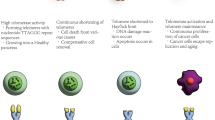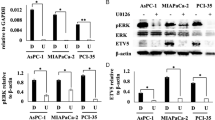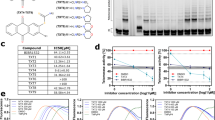Abstract
Telomerase plays a critical role in the development of cellular immortality and oncogenesis. Activation of telomerase occurs in a majority of human malignant tumours, and the relation between telomerase and vulnerability to drug-mediated apoptosis remains unclear. In this study, we demonstrate, for the first time, up-regulation of telomerase activity in human pancreatic cancer cells treated with etoposide, a topoisomerase II inhibitor. Exposure of MIA PaCa-2 cells to etoposide at various concentrations (1–30 μM) resulted in two- to threefold increases in telomerase activity. Up-regulation was detectable 24 h after drug exposure and was accompanied by enhanced expression of mRNA of the human telomerase reverse transcriptase. Telomerase activation was also observed in AsPC-1 and PANC-1 cells but not in KP-3 and KP-1N cells. Furthermore, we found a negative correlation between increased telomerase activity and the percentage of dead cells after etoposide treatment. These findings suggest the existence of an anti-apoptotic pathway through which telomerase is up-regulated in response to DNA damage. This telomerase activation pathway may be one of the mechanisms responsible for the development of etoposide resistance in certain pancreatic cancer cells. © 2000 Cancer Research Campaign
Similar content being viewed by others
Article PDF
Change history
16 November 2011
This paper was modified 12 months after initial publication to switch to Creative Commons licence terms, as noted at publication
References
Akiyama M, Horiguchi-Yamada J, Saito S, Hoshi Y, Yamada O, Mizoguchi H and Yamada H (1999) Cytostatic concentrations of anticancer agents do not affect telomerase activity of leukaemic cells in vitro. Eur J Cancer 35: 309–315
Arbuck SG (1990) Overview of chemotherapy for pancreatic cancer. Int J Pancreatol 7: 209–222
Barry MA, Reynolds JE and Eastman A (1993) Etoposide-induced apoptosis in human HL-60 cells is associated with intracellular acidification. Cancer Res 53: 2349–2357
Belair CD, Yeager TR, Lopez PM and Reznikoff CA (1997) Telomerase activity: a biomarker of cell proliferation, not malignant transformation. Proc Natl Acad Sci USA 94: 13677–13682
Bodnar AG, Ouellette M, Frolkis M, Holt SE, Chiu CP, Morin GB, Harley CB, Shay JW, Lichtsteiner S and Wright WE (1998) Extension of life-span by introduction of telomerase into normal human cells. Science 279: 349–352
Bonelli G, Sacchi MC, Barbiero G, Duranti F, Goglio G, Verdun di Cantogno L, Amenta JS, Piacentini M, Tacchetti C and Baccino FM (1996) Apoptosis of L929 cells by etoposide: a quantitative and kinetic approach. Exp Cell Res 228: 292–305
Fan S, El-Deiry WS, Bae I, Freeman J, Jondle D, Bhatia K, Fornace AJ Jr, Magrath I, Kohn KW and O’Connor PM (1994) p53 gene mutations are associated with decreased sensitivity of human lymphoma cells to DNA damaging agents. Cancer Res 54: 5824–5830
Faraoni I, Turriziani M, Masci G, De Vecchis L, Shay JW, Bonmassar E and Graziani G (1997) Decline in telomerase activity as a measure of tumor cell killing by antineoplastic agent in vitro. Clin Cancer Res 3: 579–585
Feng J, Funk WD, Wang SS, Weinrich SL, Avilion AA, Chiu CP, Adams RR, Chang E, Allsopp RC, Yu J, Le S, West MD, Harley CB, Andrews WH, Greider CW and Villeponteau B (1995) The RNA component of human telomerase. Science 269: 1236–1241
Flint J, Craddock CF, Villegas A, Bentley DP, Williams HJ, Galanello R, Cao A, Wood WG, Ayyub H and Higgs DR (1994) Healing of broken human chromosomes by the addition of telomeric repeats. Am J Hum Genet 55: 505–512
Fu W, Begley JG, Killen MW and Mattson MP (1999) Anti-apoptotic role of telomerase in pheochromocytoma cells. J Biol Chem 274: 7264–7271
Hande KR (1998) Etoposide: four decades of development of a topoisomerase II inhibitor. Eur J Cancer 34: 1514–1521
Harley CB, Kim NW, Prowse KR, Weinrich SL, Hirsch KS, West MD, Bacchetti S, Hirte HW, Counter CM, Greider CW, Piatyszek MA, Wright WE and Shay JW (1994) Telomerase, cell immortality, and cancer. Cold Spring Harb Symp Quant Biol 59: 307–315
Harrington L, McPhail T, Mar V, Zhou W, Oulton R, Bass MB, Arruda I and Robinson MO (1997) A mammalian telomerase-associated protein. Science 275: 973–977
Hickman JA (1996) Apoptosis and chemotherapy resistance. Eur J Cancer 32A: 921–926
Holt SE, Aisner DL, Shay JW and Wright WE (1997) Lack of cell cycle regulation of telomerase activity in human cells. Proc Natl Acad Sci USA 94: 10687–10692
Holt SE, Glinsky VV, Ivanova AB and Glinsky GV (1999) Resistance to apoptosis in human cells conferred by telomerase function and telomere stability. Mol Carcinog 25: 241–248
Huschtscha LI, Bartier WA, Ross CE and Tattersall MH (1996) Characteristics of cancer cell death after exposure to cytotoxic drugs in vitro. Br J Cancer 73: 54–60
Iguchi H, Morita R, Yasuda D, Takayanagi R, Ikeda Y, Takada Y, Shimazoe Y, Nawata H and Kono A (1994) Alterations of the p53 tumor suppressor gene and Ki- ras oncogene in human pancreatic cancer-derived cell lines with different metastatic potential. Oncol Rep 1: 1223–1227
Kerr JF, Winterford CM and Harmon BV (1994) Apoptosis. Its significance in cancer and cancer therapy. Cancer 73: 2013–2026
Kim NW, Piatyszek MA, Prowse KR, Harley CB, West MD, Ho PL, Coviello GM, Wright WE, Weinrich SL and Shay JW (1994) Specific association of human telomerase activity with immortal cells and cancer. Science 266: 2011–2015
Kondo Y, Kondo S, Tanaka Y, Haqqi T, Barna BP and Cowell JK (1998) Inhibition of telomerase increases the susceptibility of human malignant glioblastoma cells to cisplatin-induced apoptosis. Oncogene 16: 2243–2248
Ku WC, Cheng AJ and Wang TC (1997) Inhibition of telomerase activity by PKC inhibitors in human nasopharyngeal cancer cells in culture. Biochem Biophys Res Commun 241: 730–736
Lee HW, Blasco MA, Gottlieb GJ, Horner JW, Greider CW and DePinho RA (1998) Essential role of mouse telomerase in highly proliferative organs. Nature 392: 569–574
Leteurtre F, Li X, Gluckman E and Carosella ED (1997) Telomerase activity during the cell cycle and in gamma-irradiated hematopoietic cells. Leukemia 11: 1681–1689
Lionetto R, Pugliese V, Bruzzi P and Rosso R (1995) No standard treatment is available for advanced pancreatic cancer. Eur J Cancer 31A: 882–887
Lock RB and Stribinskiene L (1996) Dual modes of death induced by etoposide in human epithelial tumor cells allow Bcl-2 to inhibit apoptosis without affecting clonogenic survival. Cancer Res 56: 4006–4012
Lowe SW, Bodis S, McClatchey A, Remington L, Ruley HE, Fisher DE, Housman DE and Jacks T (1994) p53 status and the efficacy of cancer therapy in vivo. Science 266: 807–810
Lowe SW, Ruley HE, Jacks T and Housman DE (1993) p53-dependent apoptosis modulates the cytotoxicity of anticancer agents. Cell 74: 957–967
Meyerson M, Counter CM, Eaton EN, Ellisen LW, Steiner P, Caddle SD, Ziaugra L, Beijersbergen RL, Davidoff MJ, Liu Q, Bacchetti S, Haber DA and Weinberg RA (1997) hEST2, the putative human telomerase catalytic subunit gene, is up-regulated in tumor cells and during immortalization. Cell 90: 785–795
Mizumoto K, Rothman RJ and Farber JL (1994) Programmed cell death (apoptosis) of mouse fibroblasts is induced by the topoisomerase II inhibitor etoposide. Mol Pharmacol 46: 890–895
Morin GB (1989) The human telomere terminal transferase enzyme is a ribonucleoprotein that synthesizes TTAGGG repeats. Cell 59: 521–529
Nakamura TM, Morin GB, Chapman KB, Weinrich SL, Andrews WH, Lingner J, Harley CB and Cech TR (1997) Telomerase catalytic subunit homologs from fission yeast and human. Science 277: 955–959
Nakayama J, Saito M, Nakamura H, Matsuura A and Ishikawa F (1997) TLP1: a gene encoding a protein component of mammalian telomerase is a novel member of WD repeats family. Cell 88: 875–884
Niederhuber JE, Brennan MF and Menck HR (1995) The National Cancer Data Base report on pancreatic cancer. Cancer 76: 1671–1677
O’Connor PM, Jackman J, Bae I, Myers TG, Fan S, Mutoh M, Scudiero DA, Monks A, Sausville EA, Weinstein JN, Friend S, Fornace AJ Jr and Kohn KW (1997) Characterization of the p53 tumor suppressor pathway in cell lines of the National Cancer Institute anticancer drug screen and correlations with the growth-inhibitory potency of 123 anticancer agents. Cancer Res 57: 4285–4300
Okamoto-Kubo S, Nishio K, Heike Y, Yoshida M, Ohmori T and Saijo N (1994) Apoptosis induced by etoposide in small-cell lung cancer cell lines. Cancer Chemother Pharmacol 33: 385–390
Perego P, Giarola M, Righetti SC, Supino R, Caserini C, Delia D, Pierotti MA, Miyashita T, Reed JC and Zunino F (1996) Association between cisplatin resistance and mutation of p53 gene and reduced bax expression in ovarian carcinoma cell systems. Cancer Res 56: 556–562
Reed JC, Miyashita T, Takayama S, Wang HG, Sato T, Krajewski S, Aime-Sempe C, Bodrug S, Kitada S and Hanada M (1996) BCL-2 family proteins: regulators of cell death involved in the pathogenesis of cancer and resistance to therapy. J Cell Biochem 60: 23–32
Sato N, Mizumoto K, Kusumoto M, Niiyama H, Maehara N, Ogawa T and Tanaka M (1998) 9-Hydroxyellipticine inhibits telomerase activity in human pancreatic cancer cells. FEBS Lett 441: 318–321
Schnall SF and Macdonald JS (1996) Chemotherapy of adenocarcinoma of the pancreas. Semin Surg Oncol 23: 220–228
Shay JW and Bacchetti S (1997) A survey of telomerase activity in human cancer. Eur J Cancer 33: 787–791
Suehara N, Mizumoto K, Muta T, Tominaga Y, Shimura H, Kitajima S, Hamasaki N, Tsuneyoshi M and Tanaka M (1997 a) Telomerase elevation in pancreatic ductal carcinoma compared to nonmalignant pathological states. Clin Cancer Res 3: 993–998
Suehara N, Mizumoto K, Tanaka M, Niiyama H, Yokohata K, Tominaga Y, Shimura H, Muta T and Hamasaki N (1997 b) Telomerase activity in pancreatic juice differentiates ductal carcinoma from adenoma and pancreatitis. Clin Cancer Res 3: 2479–2483
Thompson CB (1995) Apoptosis in the pathogenesis and treatment of disease. Science 267: 1456–1462
Vaziri H and Benchimol S (1998) Reconstitution of telomerase activity in normal human cells leads to elongation of telomeres and extended replicative life span. Curr Biol 8: 279–282
Warshaw AL and Fernandez-del Castillo C (1992) Pancreatic carcinoma. New Engl J Med 326: 455–465
Zhu X, Kumar R, Mandal M, Sharma N, Sharma HW, Dhingra U, Sokoloski JA, Hsiao R and Narayanan R (1996) Cell cycle-dependent modulation of telomerase activity in tumor cells. Proc Natl Acad Sci USA 93: 6091–6095
Author information
Authors and Affiliations
Rights and permissions
From twelve months after its original publication, this work is licensed under the Creative Commons Attribution-NonCommercial-Share Alike 3.0 Unported License. To view a copy of this license, visit http://creativecommons.org/licenses/by-nc-sa/3.0/
About this article
Cite this article
Sato, N., Mizumoto, K., Kusumoto, M. et al. Up-regulation of telomerase activity in human pancreatic cancer cells after exposure to etoposide. Br J Cancer 82, 1819–1826 (2000). https://doi.org/10.1054/bjoc.2000.1117
Received:
Revised:
Accepted:
Published:
Issue date:
DOI: https://doi.org/10.1054/bjoc.2000.1117



